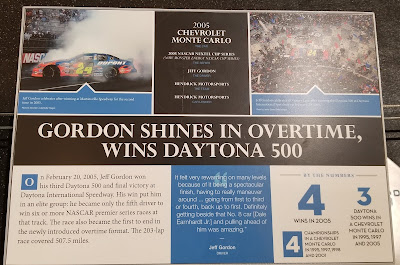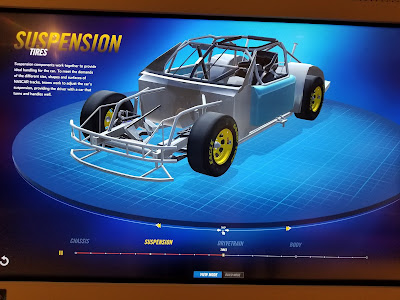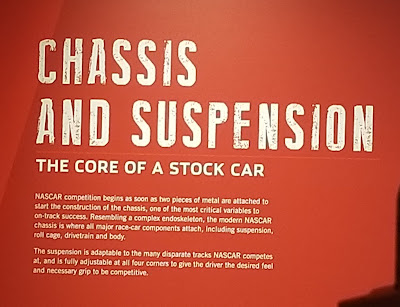#68 NASCAR
Wednesday October
16, 2019
Who knew the NASCAR Hall of Fame would be so much fun? Derrille and I are fans…not avid fans but we enjoy watching the races. This Hall of Fame exceeded my expectations! In my hope to share this day with you, this blog is a bit long.
We were camped in Fort Mills, SC, just a few miles south
of Charlotte, NC. The morning we drove into town the rain came down in
torrents. The car in front of us barely
showed in the gray, rainy day. The Hall of Fame advertised parking next door.
However, the lot serves the convention center which was having a big
doings. No parking! The attendant said to go around the block
and go into reserved parking, he would call ahead. He did. We parked. Except the rain continued to dump from the
skies and deep puddles covered the ground.
We entered the building thoroughly soaked from head to toe!
We wondered why workers were washing the building in the rain. Then we learned that a flock of birds had crashed into the windows during the night, and they were part of the cleanup. The entry
Brick pavers cover the museum exterior entry. Many have been purchased in the memory of the racing personnel.
The lobby ticket counter offers several admission packages. We chose one that gave you a hard card and a lanyard. You registered your card and then used it to open some of the digital reader boards.
This fuel canister holds the camera. I decided to have our photo taken, and was
pleased with the results.
The High Octane Theater gives the overview and a bit of history of the sport. The theater format puts you in the track grandstands.
The icons of glory road show how steering wheels have changed over the years. In 1957 the wheel and dashboard looked like a regular street car.
Glory Road starts with the 1952 Hudson Hornet. The race tracks at this time had 0 degree
banking.
As you go up the road each track has a reader board as well as one for each car. Note the degree of banking as we go up. It also states the year the track opened.
We did not realize that the asphalt on each track differs greatly! The Phoenix track has more sand. The New Hampshire asphalt is rough and rocky. One track even has concrete.
The Glory Road banking tips from 0 degrees to 33 degrees,
although the cars stop at 31 degrees of banking.
Darrell Waltrip’s number 88 car shows how far racing had
come since 1976. Check out the
interior! The headrest is wrapped in
duct tape! Darrell can be found in the announcer's booth these days.
Evergreen Speedway in Monroe, Washington made the race
track reader boards.
We chuckled at the sponsor by the rear tire: Farmer Don’s Ham.
Here is Derrille standing on the track at 14 degrees of banking.
Here we are at 25 degrees of banking.
Jeff Gordon was Derrille’s favorite driver in car 24. When Jeff retired he chose Chase Elliot who took over car 24. Then Chase moved to another team and drives Car 9, and is the one Derrille follows. Jeff has moved to the announcer's booth, too.
My favorite is Jimmy Johnson in car 48. He hasn’t been winning, but I still root for him. Check out the banking at 29 degrees.
For all you Kyle Busch fans. Or for those of you who just like the M&M car!
These two speedways seem to be favorites. Check out the banking numbers. Also Bristol was the only track we found using a concrete surface.
This cutie , Lightening McQueen from Cars, sits outside
the Hall of Fame section.
Five cars and their drivers take center court in The Hall
of Honor. Each section includes their Hall of Fame marker, their car and some
of their trophies.
Roger Penske’s Pontiac. He was in Indy driver, then stock car driver and went on to become an owner.
Jack Roush a mathematician by education began racing
after college and while working for the Ford company. He moved to NASCAR in
1988 and his drivers won often. He has
designed engines for Ford that are used by all the Ford teams.
Davey Allison’s father Bobby Allison has a spot in the
Hall of Fame. Davey grew up around
racing. His great personality and
versatile skills as a driver earned him and his #28 car many wins and and a
place in the Hall of Fame.
The fifth place of honor belongs to Derrille’s favorite
Jeff Gordon. Jeff started as a young boy
winning quarter-midget championships. He
went on to NASCAR and had a sensational career. The black leather coat that he
work on Saturday Night Live can be seen in the trophy case. He made appearances
on other television shows and magazine covers.
He is now a NASCAR announcer on TV.
In case you haven’t seen a grandfather clock on the race circuit. The clock is the trophy for winning the race at Martinsville.
A screen sits on top of the Hall of Fame plaques. It rotates through the 5 drivers and shows snippets of their lives on the 360 degree screen around the room.
The rest of the Hall of Honor forms an oval around the five showcased cars. Here is Richard Petty’s place of honor. Each plaque includes the date of induction at the top. Then a photo, name and nickname. A media clip of things about the person, and below that a record of their accomplishments.
The current image of Richard Petty shows the mustached man in the cowboy hat. To see the young Richard Petty produced a bit of a shock. Richard now owns a successful racing team.
The Skybox on level two looks down on the Glory Road. Comfortable overstuffed chairs provide a
place to rest it needed.
Bill France started NASCAR. More about him is to come.
Is this a cute little fan or what? Mom gave me permission to photograph him. He is three years old.
Inside NASCAR shows what goes into building a race car.
This film showed exactly how the car is built part by part. The chassis, the wheels and the motor fly in with the power point type presentation,
After watching the film you can see these models next.
The next exhibit allows you paint a car and add the decals. Great fun! Interestingly the lady who did this one painted the car gold, and my camera didn’t pick it up.
I had fun at this interactive display. You take off the spoiler on the back, and
pull out the splitter from the lower front end and then watch how they affect
the air flow over the car.
The Lowe's trailer for the car sits on display. This 53-foot rolling race shop not only carries the car, but supplies all kinds of extra parts. A team lounge is up a couple of stairs at the front end of the trailer. My camera couldn’t get a photo of that without a massive reflection from the glass door.
Every race track is different in its shape, degree of road banking, and makeup of the track. The NASCAR officials monitor the on-track aspects of the race.
The fun begins!
We went through 3 qualifying races on the simulators. Boy, do I have new found respect for what it
takes to drive a race car.
Another interactive exhibit allowed visitors to try their
hand as a pit crew member. You filled
the gas, raised the car, took off the lug nuts, pulled the tire forward, reset
the tire and released the jack and you were timed. I didn’t try this, but sure had fun watching
others.
A couple of sections were dedicated to the media part of racing on both floors 3 and 4.
Ready to race in the cars! Derrille chose the # 9 car….Chase Elliott’s
car and I took Kyle Busch’s M&M car.
There was so much to remember. I
can’t image doing this at over 200 mph on a banked track and with other cars
right next to you! I led in the first
race and then spun out. Derrille got a slow start but won when I spun out. We raced 2 more times. The third time Derrille drove car 4. Derrille came in second because he couldn’t catch another driver, I came in last and was driving in the smoke trail of the lady in front of me. It is hard to envision all of the factors a race car driver must keep in head and be ready to react in nano seconds.
Before there was SPEED there was SHINE! The 4th floor exhibits talk about the history of racing. Racing started with prohibition from 1920 to 1933. People made illegal whiskey and sold it to support their families especially during the depression. Some one had to transport the whiskey or moonshine. Federal agents chased the moonshine runners. To avoid getting caught and going to jail, the runners modified their cars to outrun the law. Then they bragged to each other and begin to compete in races to see who had the fastest car. These races are part of the NASCAR history.
A timeline runs from 1900 to 1940. I just put in a few of the panels. The top shows the development of the automobile and the bottom the development of racing. I found it interesting that automobile racing was getting started at the same time as the Wright Brothers were trying to fly. I didn’t put in the whole timeline.
Number 7 the Silver Bullet was driven by Lightening Lloyd Seay to win at Daytona August 24, 1941, just seven years before NASCAR. Racing was suspended until the end of WWII.
I found it fascinating to see how trophies changed over the years. For many years the winners received wooden trophies topped with gold cups, cars, angels, etc. Later they moved to glass obelisk, or silver bowls. The winners today get a variety of interesting trophies. Think about the grandfather clock.
At 112 mph today’s racers are hardly moving.
The development of the racing helmets showed here.
After the fuss over Danica Patrick a female racer, I was surprised
to see that she wasn’t the first woman to enter this male dominated sport.
Track spotters provide important information
to the drivers of today. Their teamwork helps insure safety and hopefully the
win.
Autographed flag from each race adorn the top of the display cases.
I didn’t realize that steering wheels came in a variety of sizes and feels to suit the drivers.
Two displays showed how a regular street car can be converted into a racing car. This model belongs to Toyota. This shows the difference between a regular car seat and a racing seat.
This exhibit shows the conversion of a street Pontiac to
a race car to gain speed.
I only photographed a couple of changes. Race cars do not have headlights. The track
is lit, but not the cars. All logo must
be removed. The dashboard is removed and
replaced with necessary gauges and switches.
The full front seat with a single seat belt must be replaced with a five point seat belt and shoulder harness, and an “anti-submarine belt which keeps the driver from sliding under his belts in a crash.
Richard Childress entered the racing world about 1969 when he bought his first race car, an old 1947 Plymouth. The car had a previously life as a taxi cab and cost Childress $20. He struggled for years on a tight budget, doing his own repair work and repair work for others to earn money. After spending 12 years as a NASCAR driver he wanted to move to the next level and run the business. He hired Dale Earnhardt to drive Richard Childress Racing #3 Pontiac in 1981.
Ricky Rudd’s racing in 1983 was pivotal for RCR. After not winning 12 races, he finally did at
two speedways.
To celebrate the anniversary RCR used a special gold paint schemes on its two Chevy Camaro. Austin Dillon, Richard’s grandson, and Daniel Hemric drive these special painted cars.
Dale Earnhardt and Childress sealed their business relationship in 1984. This started a series of wins and championships.
Dale Earnhardt died in the 2001 Daytona 500. The board says only in America can a business
survive such a devastation loss.
Childress then found Kevin Harvick and later other drivers to create the
RCR team.
This car driven by Kevin Harvick won the 2007 Daytona 500 in grand style. The car here still has the confetti on it from the winner’s circle.
The family legacy. His son, Mike holds the general
manager position in the company. Mike’s
sons, Austin and Ty both drive race cars.
Richard rose from humble beginnings. As a business entrepreneur, Childress has become one of the wealthiest men in North Carolina. He resides in one of the largest mansions in northwestern Davidson County North Carolina. The Childress museum can be seen in nearby Lexington. He also has a winery. In 2008 he and his wife Judy started the Childress Institute for Pediatric Trauma. The hope is to lead a national effort to reduce death and disability following injuries to children less than 18 years old. The Institute focuses on funding research, medical education and public awareness.
Outside the rain had stopped. The sun came out. Here are some photos of downtown Charlotte, NC. A few of Charlotte’s buildings as seen from the Hall of Fame.
Next stop: Augusta GA














































































































































































































No comments:
Post a Comment